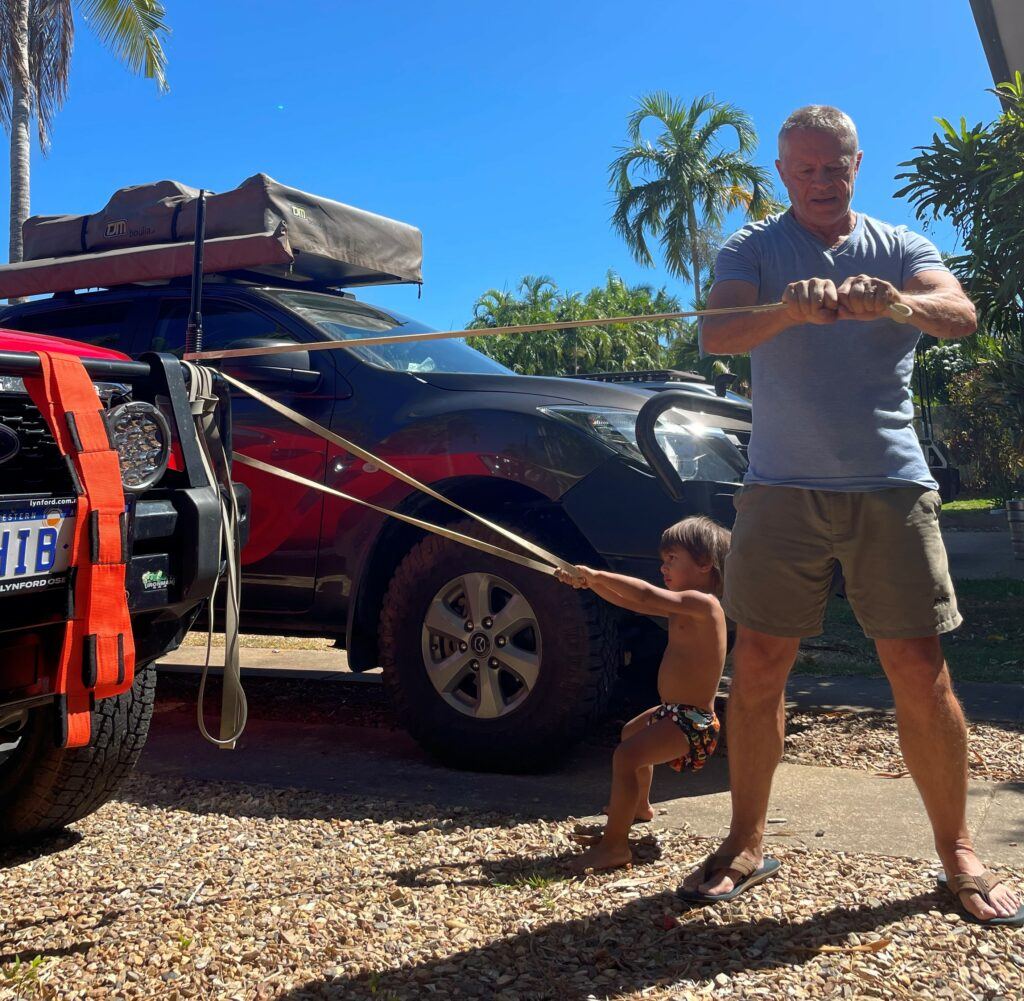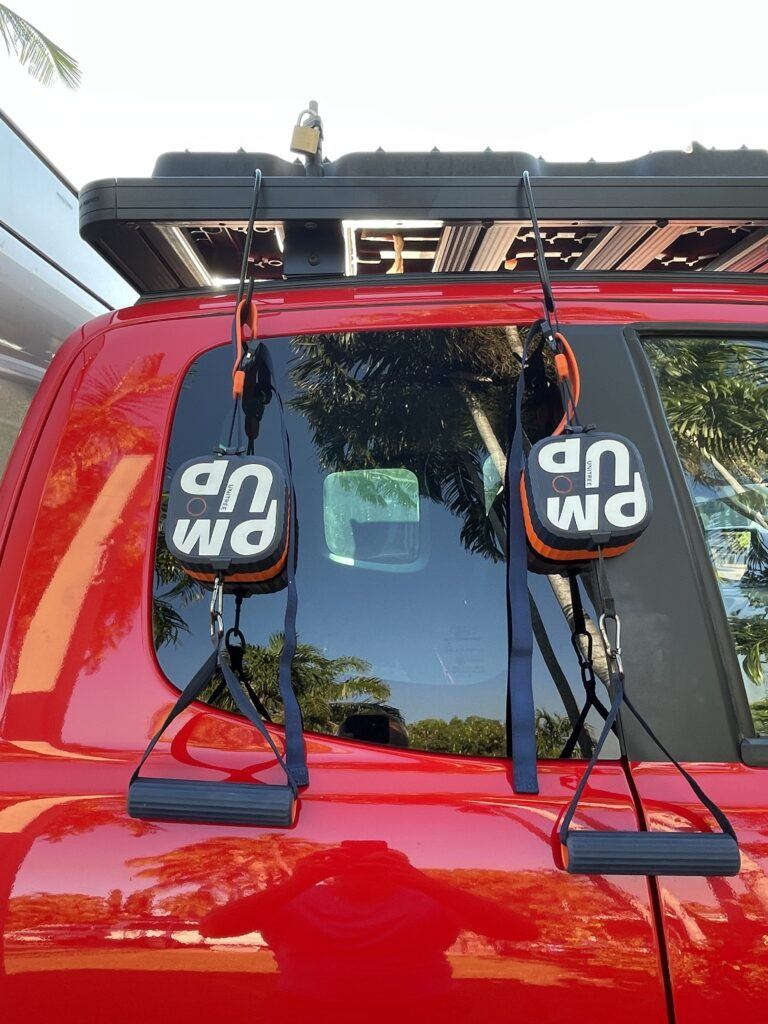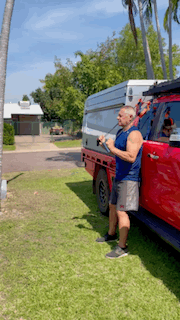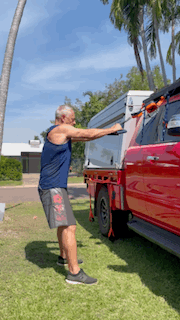Introduction
This post builds on our Previous Post where we introduced ‘consistency’, challenged traditional exercise dogma and outlined our workout protocols with an example ‘super-set’.
In this post, we will delve into our workout equipment and routines with insights into our approach to strength and health on the road.
If you are new to resistance training or coming back into it after a lengthy break - DON'T WORRY if it looks too hard. These initial posts show examples of how we workout after many years of consistent training. In our Members Area we provide a step-by-step guide to get from 'newbie' to a master of your own workout programs.
Staying Strong and Healthy on the Road
As noted in our Home Page and as avid travelers ourselves, my wife and I have embraced the nomadic lifestyle of vehicle touring and camping. We are fortunate to have close family and friends across Australia.
Our house (which is currently rented) is in Perth, and we have sons / daughter in laws, grand kids and close family living in Sydney, Canberra, Darwin and Brisbane. We often stay or base in Brisbane, Darwin and Sydney.
Our touring lifestyle takes us to all corners of Australia. The map below shows our completed and planned driving / camping trips through to 2026. Australia is a big country.

Minimal Equipment – Maximum Results
Our science-based approach revolves around optimizing your workouts with lightweight, portable and versatile equipment, ensuring that you can achieve your strength and fitness goals wherever you go. We do the same workouts with the same equipment when we are based in homes or touring and camping – it’s only the equipment mounting that differs. Age Free Strength proves that minimal equipment can deliver maximum results.
Our workouts extend beyond vehicle touring and camping alone and can fit into various settings, including home gyms and travel destinations, both domestically and internationally. We have taken our full exercise gear with us on flights - as check-in or as carry-on luggage.
In the next sections, we will dive into the equipment we recommend for our workout programs.
Become a Member to experience our Optimal Exercises and Routines.
Resistance Bands
Resistance bands are a key component of our minimal equipment at Age Free Strength.
We highly recommend 41 or 42 inch loop style layered latex bands (as opposed to molded rubber bands) for their safety, durability and effectiveness. As you can see from the images below, we have 2 pairs of bands.


showing how it’s done
Molded bands have a tendency to snap, where-as layered latex bands do not. We have personal experience with molded bands snapping – which can be dangerous.
Layered Latex bands are designed to withstand repeated stretching and, in our experience, offer a more durable option compared to molded rubber bands. We’ve had ours for 3 years and they are still as strong as new.
Resistance bands provide variable resistance (resistance increases as they stretch) and allow you to easily adjust the intensity of your workouts based on your individual strength level.
Although bands do not provide the ideal resistance curve relative to the muscles strength curve (muscles are stronger in their lengthened position i.e. when the band is least stretched), they come with significant benefits. These include being joint-friendly and enabling you to achieve the ideal anatomical motion for our exercises.
Warming up the joints is often why we begin our sets with bands prior to progressing to the PUMP cables to fully optimize muscle activation.
With band exercises, we recommend wearing gloves as bands can rub and chafe the skin.
The bands we have are the ‘X3’ bands which we bought online from OsteoStrong in Australia.
We take a pair each of X3 white and light grey bands on the road that, when used individually as a single loop, provide up to 23kg (white) and 36kg (light grey) of resistance. When doubled over, the resistance is also doubled (45kg and 73kg respectively). When paired together you can see that more than enough resistance is available with these bands.
This resistance may be too much for some people, at least initially, so we suggest searching the internet for suppliers (there are many) such as ‘Serious Steel’ that provide latex bands with lighter resistance options.
There are portable resistance band systems, such as the X3 Bar system, that mimic free weights compound exercises. The X3 system ‘works’ and is relatively safe on joints due to the bands resistance curve, but it is focused mostly on compound exercises that are not optimal.
Unitree PUMPS
The Unitree PUMP Pros are an absolute game-changer in our minimal equipment workouts. To put it simply, we are blown away by their innovation and effectiveness.
Developed by Unitree, a renowned robotics company that has received numerous awards, the PUMPS harness the power of robotics joint movement technology to deliver cable resistance training.
Equipped with a rechargeable lithium battery-powered built-in motor, the PUMPS offer incredible convenience and versatility.
Controlling the resistance is simple via Bluetooth with the accompanying smartphone app, allowing you to set the desired resistance level in precise 0.5kg increments, with a maximum resistance of 20kg per PUMP. The battery charge status is the blue graphical ring in the app screenshot image below.

While you have the option to combine up to 8 PUMPS for a total resistance of 160kg, we find that 2 PUMPS are sufficient for our minimal equipment workouts.
Functionality includes setting various resistance modes such as ‘eccentric’ or ‘concentric’ – but we typically leave it on ‘standard’ which applies constant resistance in both directions of movement.
The PUMPS can anchor to a door or to any solid object with legs, arms, bars or struts. We use our vehicle roof rack, bull bar, camper tray side rails, wheel rims and/or our feet. There is a quick release adjustable latch strap for securing the PUMPS and we also use ‘S hooks’ for fast re-positioning with the roof rack mounted exercises – see the image below.

The standard delivered accessories include ankle / wrist straps, extension leads and door anchors. Each PUMP can fit in your hand and weighs 700 grams.

Optional accessories include suction mounts that can fix to a floor or wall but we keep it simple with the basics.
A full battery charge lasts for at least 3 of our workouts, which are a combination of bodyweight, resistance bands and the PUMPS.
With our workout routines, the PUMP Pros and bands effectively replace a room full of free weights and a cable plate machine.
Interested in Unitree Pump Pros? Click here for an additional 20% discountNot an Affiliate Link
Unitree have now released a bigger, heavier and more powerful version called the PUMP Max. The Max has up to 70kg of resistance per unit, but is not as flexible or portable as the PUMP Pro. We will stick with the Pump Pros with our nomadic lifestyle.
Forearm Forklift Strap and Bodyweight
Our minimal equipment traveling gym wouldn’t be complete without the inclusion of a forearm forklift strap and the power of our own body weight.
Forearm forklift straps are commonly used by furniture removalists to facilitate safer and easier lifting and shifting of heavy items. These versatile straps can be obtained from most hardware stores, offering an affordable and convenient addition to our workout arsenal.

With three hoops on each end that allow for length control, a wide range of exercises can be exploited. Their versatility extends beyond traditional weightlifting, as they can also double as a suspension trainer, serving as an alternative to equipment like the ‘TRX’.
Additionally, the straps are excellent for isometric exercises, adding yet another dimension to our workout routines.
In the accompanying GIF images below, you can see examples of forklift strap bodyweight exercises such as the ‘pendulum sissy squat’ (a quads isolation exercise) and the horizontal pull back (middle trapezius / rear deltoid compound exercise).


We should never underestimate bodyweight exercises, with or without the forklift strap. Our routines incorporate numerous bodyweight exercises including pushups, the reverse lunge, Bulgarian split squats, calf raises and the tibialis retraction (shin muscle).
Our Touring Workouts
The next sections introduce how we workout while vehicle touring and camping and while ‘couch surfing’ in family and friend’s homes between driving trips.
At Age Free Strength we focus on the following types of workout routines:
- Full Body – best for beginners or in weeks when limited days are available.
- Lower Volume 2-Way Split (Myo-Rep protocol) – our preferred routine.
- Higher Volume 2-Way Split (Superset protocol).
- Mobility Drills with reduced Lower Volume 2-Way Split.
- Mobility Drills only.
Our Members Area details the above Routines.
We will elaborate on the muscle groups and bio-mechanics, the exercises, exercise form, volume, intensity, frequency, recovery and nutrition etc, but for this post, let's look at a summary of each workout type.
Full Body
This is where you literally work your whole body. It is recommended for beginners to become familiar with the exercises and to start building up intensity with minimal volume (number of sets) and for those of us that have limited days of the week available for resistance training.
Very few of us have the time, inclination or energy to work the whole body (18+ major muscle groups) with maximum intensity.
When doing full body routines or as a beginner, we recommend 3 workouts per week, with 1 or 2 sets per muscle group, and with at least 1 rest day between workouts. The workout can be done by combining superset pairs with 1 or 2 sets of each, or by doing and repeating 1 set of all exercises.
One of the benefits of 3 days per week full body workouts is that it leaves 4 days for active recovery, cardio and/or rest days between the workouts. You can expect the full body workouts to take between 30 to 50 minutes or longer, depending on the volume and rest.
At Age Free Strength we focus on and work 18 major muscle groups – separately, efficiently and safely – using the workout protocols outlined in our Previous Post.
These 18 major muscle groups are based on the The Brig20 Program which is one of the SmartTraining 365 programs developed by Doug Brignole and Moe Larbi.
Minor or supporting muscles are worked as a by-product of our exercises and we also have ancillary muscle groups that we work less frequently.
The 18 major muscle groups we focus on at Age Free Strength are as follows:
- Shoulders and traps – front, side and rear deltoids and upper trapezius (4 major groups) – see this post for the deltoids optimal exercises
- Chest – pectorals (1 group)
- Back – latissimus dorsi (lats) and middle trapezius (2 groups)
- Biceps (1 group)
- Triceps (1 group)
- Abdominals (1 group)
- External obliques (1 group)
- Spinal Erectors (1 group)
- Glutes (1 group)
- Hip Flexors (1 group)
- Quadriceps (1 group)
- Hamstrings (1 group)
- Calves (1 group)
- Tibialis (shin muscle) (1 group)
The ancillary muscle groups that we work directly but less frequently include:
- Neck
- Forearms
- Internal Obliques
- Infraspinatus (the main culprit with shoulder pain)
As you can see from the above list, a full body workout covers a lot of muscle groups which is one reason why 1 or 2 sets per body part is enough. In our Members Only section we provide workout routines and programs with optimal and optional muscle group exercises.
A feature of our exercises is improved mobility and flexibility with no unnatural joint stress or injuries. All of our exercises move the joints in their optimal anatomical motion and through a full range of motion which translates into an active vibrant lifestyle.
Become a Member to experience our Optimal Exercises and Routines.
2-Way Split
The 2-way split is our ‘go to’ routine when we are based in homes, travelling and on camping tours.
With our 2-way splits we often rotate and alternate Higher Volume routines (up to 3 or 4 sets per muscle group), pairing disparate muscle groups into super-sets, with Lower Volume routines (1 activation set per muscle group plus Myo-Rep rest/pause mini sets).
Our preferred and most commonly executed routine is the Lower Volume 2-way Split.
Myo-Reps are a great way to maximize muscle growth while minimizing workout duration. The Myo-Reps rest/pause protocol we favor takes the first ‘activation’ set of 15 reps close to failure followed by 5 deep breaths (about 15 seconds) and then mini-sets of 3 to 5 reps using the same weight resistance. Repeat the 5 deep breaths and mini-sets until you cannot do 3 reps. This typically takes 3 or 4 mini-sets with around 15 Myo-Reps.
The high-volume super-set groups are either opposing muscles e.g. chest and lats (see Previous Post) and/or muscle groups that use the same or similar equipment setup e.g. Unitree PUMPS for the triceps isolation exercise and the rear deltoids compound exercise (cross body straight arms pull away), in the GIF videos below.


There are other, popular, 2-way splits and 3-way splits including upper body/lower body and push day/pull day/legs day etc. We will delve into these and other split options in our Members Area.
Alternating our 2-way splits every other day means that each muscle group is directly hit twice every 5 days and some indirectly hit every 3rd day in the other split – all of which allows for adequate muscle and central nervous system recovery.
Note that we all can have differences in terms of our individual biomechanics, our intensity threshold and how we recover.
A typical higher volume 2-way split takes approximately 30 to 40 minutes, lower volume approximately 30 minutes – or less time for both if we omit the legs and core exercises when we are trekking.
We seek touring and camping destinations with access to scenic walks and treks, many of which include challenging rocky or step climbs and descents. These treks replace our resistance exercises for legs (calves, tibialis, quads, hamstrings and glutes) and core (abs, external obliques, hip flexors and spinal erectors).
Below is a one example of how we structure our 2-way splits with Higher Volume super-sets. The yellow highlighted exercises are those that are omitted when we are trekking.
Split 1 – with super-sets of 9 major muscle groups
- Chest and Lats
- Abs and Spinal Erectors
- Quads, Calves and Tibialis
- Side Deltoids and Front Deltoids
Split 2 – with super-sets of 9 major muscle groups
- Triceps and Rear Deltoids
- Glutes, Hamstrings and Hip Flexors (leg pulls)
- Middle Trapezius (middle back) and External Obliques
- Biceps and Upper Trapezius (shrugs)
On days when we are trekking, we often do an upper body only split prior to the trek…… if we have the energy.
Next Post
Stay tuned for our next post where we will delve deeper into specific exercise bio-mechanics and exercise form with a focus on the shoulders.

Great videos and information, Jeff! I like your explanation of the different workouts. Keen to try these at home. Looking forward to future posts!
Thanks Jarrad. More posts coming up & a subscription video library
Wow! I love your explanation regarding workout Keep Writing, Keep sharing
Thanks. Currently touring & camping. More posts coming up in a few weeks, stay tuned
Great info Jeff. I look forward to more of your posts
Thanks Victor. We’ve been on the road touring/camping for the past couple of months. A couple more posts & a subscription exercise/routine library coming up soon.